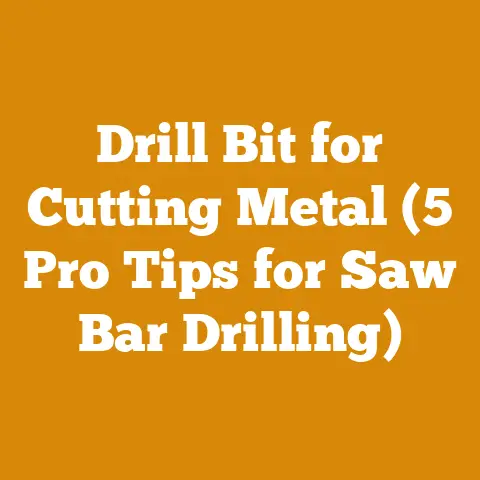Chainsaw Bar Dressing Tool Guide (5 Pro Tips for Sharp Bars)
I’ve always believed that the true testament to a logger’s skill isn’t just felling trees, but maintaining the tools that make it all possible. Among these, the chainsaw stands supreme, and its heart lies in the bar and chain. A dull chain is more than an inconvenience; it’s a safety hazard, a time sink, and a drain on your chainsaw’s lifespan. That’s why I’m here to share my hard-earned wisdom on using a chainsaw bar dressing tool to keep your bars sharp and your operations smooth. This guide isn’t just about tools; it’s about endurance, efficiency, and respect for the craft.
Why Chainsaw Bar Maintenance Matters
Think of your chainsaw bar as the foundation of your cutting operation. A damaged or worn bar can lead to:
- Reduced Cutting Efficiency: A pinched or uneven bar increases friction, slowing down your cuts and requiring more effort.
- Premature Chain Wear: A rough bar surface accelerates wear on your chain, shortening its lifespan and increasing replacement costs.
- Increased Risk of Kickback: An uneven bar can cause the chain to bind, increasing the risk of dangerous kickback.
- Damage to the Chainsaw: Excessive friction can strain the chainsaw’s motor, leading to overheating and potential damage.
Maintaining your bar is not just about convenience; it’s about safety, cost-effectiveness, and prolonging the life of your equipment. It’s an investment that pays off in the long run.
Identifying the Need for Bar Dressing
Before you start grinding away, you need to know what to look for. Here are some key indicators that your chainsaw bar needs dressing:
- Burrs on the Bar Rails: These are small, raised edges that form on the sides of the bar rails due to friction and wear. Run your finger along the rail (carefully!) and feel for any roughness.
- Uneven Bar Rails: Over time, one side of the bar rail may wear down more than the other, leading to an uneven cutting surface. Use a straight edge to check for discrepancies.
- Pinched Bar: This occurs when the bar rails are squeezed together, usually due to cutting in dirty or abrasive conditions. A pinched bar will cause the chain to bind.
- Worn Sprocket Nose: If your bar has a sprocket nose (the rotating tip), check for wear or damage. A worn sprocket nose can cause the chain to jump or derail.
- Difficulty Making Straight Cuts: If you’re struggling to make straight cuts, even with a sharp chain, the bar may be the culprit.
My Experience: I remember one time, I was cutting some seasoned oak, and I kept noticing the chain was binding. I sharpened the chain twice, but it didn’t solve the problem. Turns out, the bar rails were severely pinched from cutting near the ground. A little dressing, and the saw was cutting like new again.
Tools of the Trade: Chainsaw Bar Dressing Tools
There are several tools available for dressing your chainsaw bar, each with its own advantages and disadvantages. Here’s a rundown of the most common options:
-
Flat File: A basic flat file is an inexpensive and versatile tool for removing burrs and smoothing the bar rails. Look for a file with a coarse grit for initial shaping and a fine grit for finishing.
- Pros: Affordable, readily available, easy to use.
- Cons: Can be time-consuming for heavily damaged bars, requires a steady hand.
-
Bar Rail Dresser: These specialized tools feature a guide that helps you maintain a consistent angle while filing the bar rails. They are available in various designs, some with adjustable angles.
-
Pros: Easier to maintain a consistent angle, faster than a flat file.
- Cons: More expensive than a flat file, may not be suitable for all bar types.
-
Grinding Wheel (Angle Grinder): An angle grinder with a fine-grit grinding wheel can quickly remove material and reshape the bar rails. However, it requires a steady hand and a good understanding of metalworking.
-
Pros: Fast and efficient for heavily damaged bars.
- Cons: Requires experience, can easily remove too much material, potential for overheating the bar.
-
Chainsaw Bar Grinder: These are purpose-built machines designed specifically for dressing chainsaw bars. They offer precise control and consistent results.
-
Pros: Precise, efficient, ideal for professional use.
- Cons: Expensive, requires dedicated workspace.
- Combination Tools: Some tools combine features of different types, such as a file with a built-in depth gauge or a bar rail dresser with a grinding wheel attachment.
Tool Recommendations: For most users, I recommend starting with a good quality flat file and a bar rail dresser. These tools are affordable, versatile, and easy to learn. If you’re a professional logger or use your chainsaw frequently, consider investing in a chainsaw bar grinder for maximum precision and efficiency.
Pro Tip 1: Preparing Your Chainsaw Bar for Dressing
Before you start dressing your bar, it’s essential to prepare it properly. This will ensure a clean and accurate result.
- Clean the Bar: Remove any dirt, debris, or sawdust from the bar using a wire brush or compressed air. A clean surface will allow you to see the wear and damage more clearly.
- Inspect the Bar: Carefully examine the bar for any signs of damage, such as cracks, bends, or excessive wear. If the bar is severely damaged, it may need to be replaced.
- Secure the Bar: Clamp the bar securely in a vise or use a bar mounting stand. This will prevent the bar from moving while you’re working on it.
- Lubricate the Bar: Apply a thin coat of bar and chain oil to the bar rails. This will help the file or grinding wheel glide smoothly and prevent overheating.
Safety First: Always wear safety glasses and gloves when working with chainsaw bar dressing tools. Metal filings and sparks can be dangerous.
Pro Tip 2: Mastering the Flat File Technique
The flat file is a versatile tool for removing burrs and smoothing the bar rails. Here’s how to use it effectively:
- Choose the Right File: Use a coarse file for removing burrs and a fine file for smoothing.
- Hold the File at the Correct Angle: Hold the file at a slight angle to the bar rail, typically around 10-15 degrees. This will help you remove material evenly.
- Use Smooth, Even Strokes: Apply consistent pressure and use long, smooth strokes. Avoid jerky or uneven movements.
- File in One Direction: File in one direction only, lifting the file on the return stroke. This will prevent the file from clogging and ensure a clean cut.
- Check Your Progress: Regularly check your progress with a straight edge or by running your finger along the bar rail.
My Personal Tip: I like to use a marker to color the bar rail before filing. As I file, the marker disappears, showing me exactly where I’m removing material. This helps me maintain a consistent angle and avoid over-filing.
Pro Tip 3: Utilizing a Bar Rail Dresser for Precision
A bar rail dresser makes it easier to maintain a consistent angle and achieve a professional-looking result.
- Select the Correct Angle: Most bar rail dressers have adjustable angles. Consult your chainsaw’s manual or the bar manufacturer’s specifications to determine the correct angle for your bar.
- Secure the Dresser to the Bar: Attach the bar rail dresser to the bar, ensuring that it is properly aligned.
- File with Consistent Pressure: Use smooth, even strokes, applying consistent pressure. The dresser will guide the file and help you maintain the correct angle.
- Check for Evenness: Regularly check the bar rail for evenness using a straight edge.
- Repeat on the Other Rail: Repeat the process on the other bar rail, ensuring that both rails are even and parallel.
Important Note: Some bar rail dressers are designed for specific bar types. Make sure you choose a dresser that is compatible with your bar.
Pro Tip 4: The Art of Angle Grinding (Use with Caution!)
Using an angle grinder to dress a chainsaw bar requires experience and caution. It’s easy to remove too much material or overheat the bar. If you’re not comfortable with metalworking, I recommend sticking to a flat file or bar rail dresser.
- Choose the Right Grinding Wheel: Use a fine-grit grinding wheel designed for metal finishing. Avoid using coarse wheels, as they can remove material too quickly.
- Wear Safety Gear: Always wear safety glasses, gloves, and a face shield when using an angle grinder.
- Secure the Bar: Clamp the bar securely in a vise.
- Use Light Pressure: Apply light pressure and keep the grinder moving. Avoid dwelling in one spot, as this can overheat the bar.
- Maintain a Consistent Angle: Hold the grinder at a slight angle to the bar rail, typically around 10-15 degrees.
- Cool the Bar Regularly: Dip the bar in water frequently to prevent overheating. Overheating can weaken the metal and cause the bar to warp.
- Check Your Progress: Regularly check your progress with a straight edge.
Safety Warning: Angle grinders are powerful tools. Use extreme caution and follow all safety guidelines.
Pro Tip 5: Finishing Touches and Maintenance
Once you’ve dressed the bar rails, it’s time for the finishing touches.
- Deburr the Bar: Use a fine file or a deburring tool to remove any sharp edges or burrs from the bar rails.
- Clean the Bar Groove: Use a bar groove cleaner or a small screwdriver to remove any dirt or debris from the bar groove (the slot that the chain runs in).
- Check the Sprocket Nose (if applicable): If your bar has a sprocket nose, make sure it spins freely and is properly lubricated. Replace the sprocket nose if it is worn or damaged.
- Lubricate the Bar: Apply a generous amount of bar and chain oil to the bar rails and the bar groove.
- Check Chain Tension: Install the chain and check the tension. The chain should be snug but still able to be pulled around the bar by hand.
Long-Term Maintenance:
- Regular Cleaning: Clean your chainsaw bar after each use to remove dirt and debris.
- Proper Lubrication: Use a high-quality bar and chain oil and ensure that the oiler is functioning properly.
- Chain Sharpening: Sharpen your chain regularly to reduce wear on the bar.
- Rotation: Rotate your bar periodically to distribute wear evenly. Flip the bar over each time you change the chain.
- Storage: Store your chainsaw in a dry place to prevent rust and corrosion.
My Story: I once neglected to clean my bar after cutting some particularly sappy pine. The sap hardened in the bar groove, causing the chain to bind and overheat. It took me a good hour to clean it out, and I learned a valuable lesson about the importance of regular maintenance.
Understanding Chainsaw Bar Wear Patterns
Different cutting conditions and techniques can lead to distinct wear patterns on your chainsaw bar. Recognizing these patterns can help you tailor your maintenance and cutting practices.
- Even Wear: This indicates proper chain tension, lubrication, and cutting technique. The bar rails wear down uniformly.
- Uneven Wear: This suggests improper chain tension, lubrication issues, or cutting with excessive pressure on one side of the bar. One rail will be more worn than the other.
- Pinched Bar: This is caused by cutting in dirty conditions or forcing the saw through the cut. The bar rails are squeezed together.
- Burrs on the Rails: This is a common sign of normal wear and tear. Burrs form due to friction between the chain and the bar.
- Worn Sprocket Nose: This is typical for bars with sprocket noses. The sprocket wears down over time due to friction.
Case Study: I worked on a logging project where we were cutting a lot of redwood. The redwood dust was very abrasive, and we noticed that our bars were wearing down much faster than usual. We started cleaning and lubricating the bars more frequently, and that helped to slow down the wear.
When to Replace Your Chainsaw Bar
Even with proper maintenance, chainsaw bars eventually wear out and need to be replaced. Here are some signs that it’s time for a new bar:
- Excessive Wear: If the bar rails are worn down to the point where they are significantly thinner than the original thickness, it’s time for a new bar.
- Cracks or Bends: Any cracks or bends in the bar are a serious safety hazard. Replace the bar immediately.
- Inability to Maintain Chain Tension: If you can no longer maintain proper chain tension, even with a new chain, the bar may be worn out.
- Excessive Vibration: If the chainsaw vibrates excessively, even with a sharp chain and a properly maintained engine, the bar may be the culprit.
Cost-Benefit Analysis: While it may be tempting to keep using a worn bar to save money, it’s important to consider the long-term costs. A worn bar can damage your chain, reduce cutting efficiency, and increase the risk of accidents. Replacing the bar is often the most cost-effective solution in the long run.
Safety Considerations for Chainsaw Bar Maintenance
Safety should always be your top priority when working with chainsaws and related tools. Here are some important safety considerations for chainsaw bar maintenance:
- Wear Safety Gear: Always wear safety glasses, gloves, and a face shield when working with chainsaw bar dressing tools.
- Disconnect the Spark Plug: Before performing any maintenance on your chainsaw, disconnect the spark plug to prevent accidental starting.
- Secure the Bar: Always secure the bar in a vise or a bar mounting stand before working on it.
- Use Caution with Angle Grinders: Angle grinders are powerful tools. Use extreme caution and follow all safety guidelines.
- Dispose of Metal Filings Properly: Metal filings can be sharp and dangerous. Dispose of them properly in a designated container.
- Read the Manual: Always read and understand the manufacturer’s instructions for your chainsaw and bar dressing tools.
My Close Call: I once forgot to disconnect the spark plug before sharpening my chain. I accidentally bumped the throttle, and the chainsaw started up. Luckily, I wasn’t injured, but it was a close call. I learned my lesson and always double-check the spark plug now.
Addressing Common Chainsaw Bar Problems
Even with proper maintenance, you may encounter some common problems with your chainsaw bar. Here’s how to address them:
- Chain Binding: This can be caused by a pinched bar, a dull chain, or insufficient lubrication. Dress the bar, sharpen the chain, and check the oiler.
- Chain Derailment: This can be caused by a worn sprocket nose, improper chain tension, or a damaged chain. Replace the sprocket nose, adjust the chain tension, and inspect the chain for damage.
- Uneven Cutting: This can be caused by an uneven bar, a dull chain, or cutting with excessive pressure on one side of the bar. Dress the bar, sharpen the chain, and use proper cutting technique.
- Overheating: This can be caused by insufficient lubrication, a dull chain, or cutting in dirty conditions. Check the oiler, sharpen the chain, and clean the bar frequently.
Troubleshooting Tip: When troubleshooting chainsaw problems, start with the simplest solutions first. Check the chain tension, lubrication, and sharpness before moving on to more complex issues.
The Future of Chainsaw Bar Technology
Chainsaw technology is constantly evolving, and new innovations are emerging all the time. Here are some trends to watch for in the future of chainsaw bars:
- Improved Materials: Manufacturers are developing new materials that are more durable, lightweight, and resistant to wear.
- Advanced Coatings: Coatings are being used to reduce friction and improve lubrication.
- Automatic Bar Oilers: Some chainsaws now feature automatic bar oilers that adjust the oil flow based on cutting conditions.
- Smart Technology: Sensors are being integrated into chainsaw bars to monitor wear, temperature, and other parameters.
My Prediction: I believe that we will see more and more smart technology integrated into chainsaws in the future. This will allow us to monitor the performance of our saws in real-time and optimize our maintenance practices.
Conclusion: The Sharp Edge of Efficiency
Mastering the art of chainsaw bar dressing is an investment in the longevity of your equipment, the safety of your operations, and the efficiency of your work. By understanding the principles outlined in this guide and applying the pro tips I’ve shared, you’ll be well-equipped to keep your chainsaw bars in top condition. Remember, a sharp bar is not just about making clean cuts; it’s about working smarter, safer, and with a deeper appreciation for the tools that empower us to shape the world around us. Now, go forth and keep those bars sharp!






